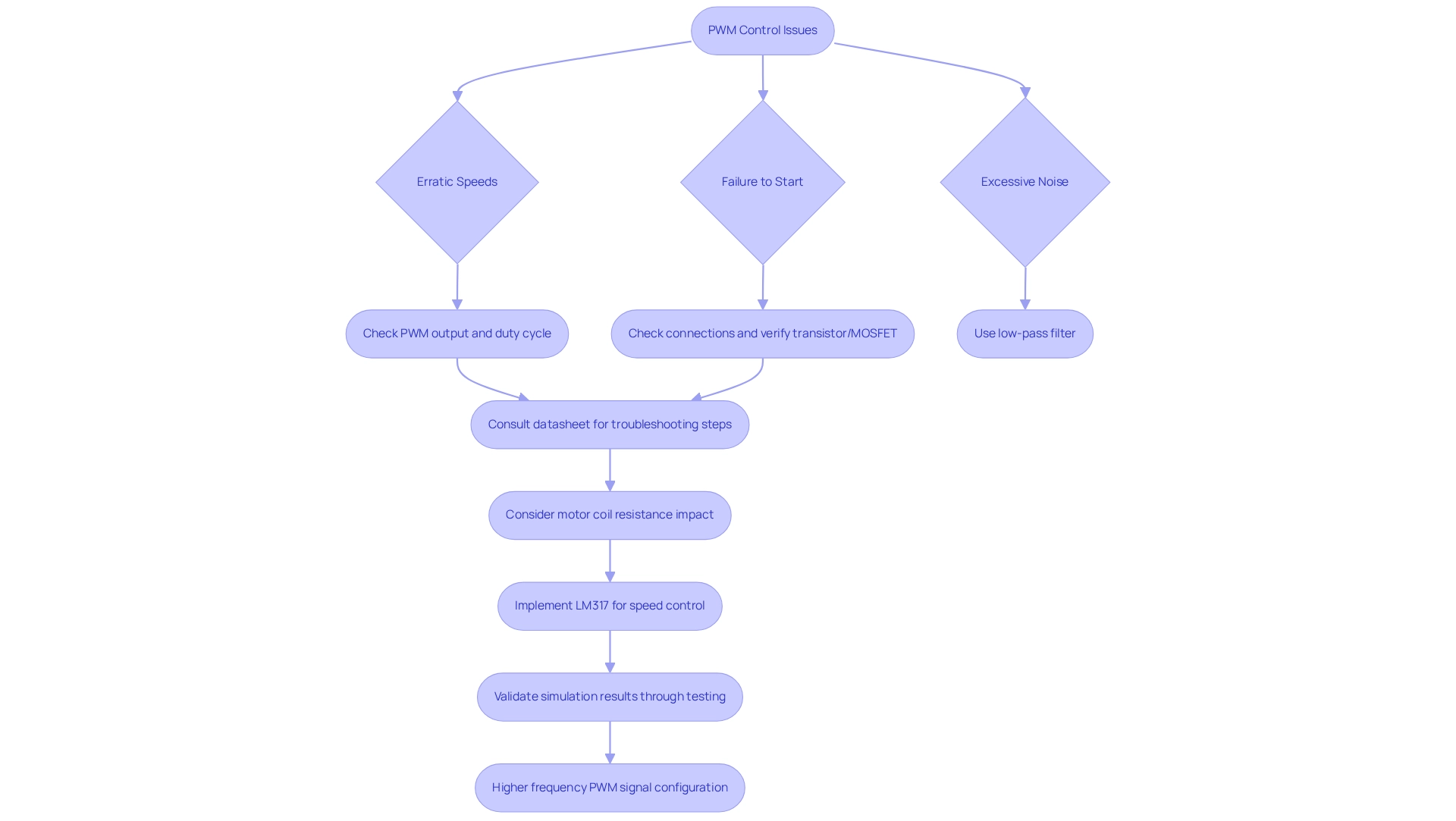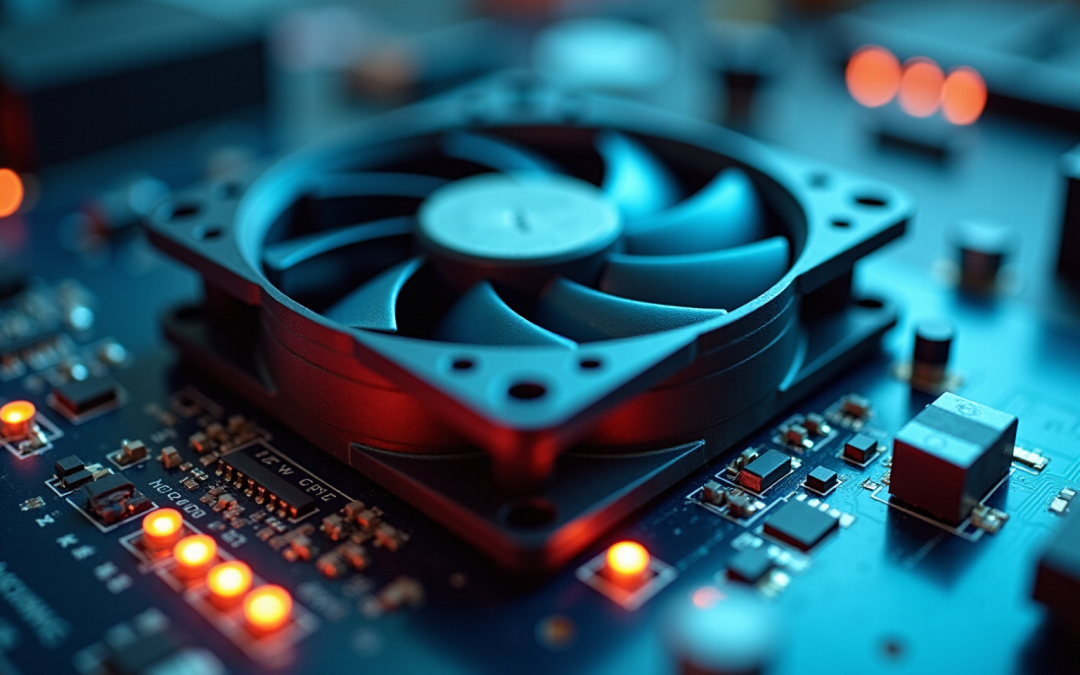Overview
This article delves into essential practices for engineers striving to master Pulse Width Modulation (PWM) control for 12V fans. It underscores the critical role of:
- Duty cycle adjustment
- Component selection
- Troubleshooting techniques
By elucidating how precise PWM control not only enhances performance but also boosts energy efficiency, the article lays out best practices for component configuration. Additionally, it addresses common challenges encountered in PWM applications, offering actionable insights that empower engineers to optimize their designs effectively.
Introduction
In the realm of electronics, effective cooling solutions are paramount, especially in managing the temperatures of 12V fans. Pulse Width Modulation (PWM) stands out as a pivotal technique, enabling engineers to precisely control fan speeds and optimize performance while minimizing energy consumption.
This article explores the intricacies of PWM control, beginning with an understanding of its fundamental principles and progressing to the selection of appropriate components and troubleshooting common issues.
By examining recent advancements and expert insights, it becomes evident that mastering PWM technology is essential for the development of efficient cooling systems in today’s demanding applications.
Understand PWM Control Basics for 12V Fans
Pulse Width Modulation (PWM) serves as a critical method for regulating the rate of 12V fan PWM by adjusting the width of the pulses in the control message. The duty cycle, which represents the percentage of time the waveform is ‘on’ compared to ‘off’ within a designated timeframe, is fundamental to fan operation. For example, means the fan operates for half the time, effectively reducing its speed to approximately half. This relationship between duty cycle and rotor speed is essential for enhancing both performance and energy efficiency.
Moreover, the frequency of the PWM waveform influences the device’s responsiveness and noise levels, with typical operating frequencies for most 4-pin motors ranging from 25 kHz to 30 kHz. It is advisable for engineers to consult the fan’s datasheet to ascertain the optimal PWM frequency tailored to their specific applications.
Recent advancements in PWM control have yielded improved thermal management solutions, as evidenced by case studies involving devices such as the ADM1029 and ADM1030/31 from Analog Devices. These devices not only monitor temperature but also facilitate automatic control and fan-speed measurement, effectively addressing the increasing thermal demands of contemporary computing systems.
Industry experts emphasize the critical role of duty cycle in PWM applications. As highlighted by professionals in the field, adjusting the duty cycle can result in reduced airflow, noise, and power consumption when systems operate at nominal levels. This underscores the necessity of precise control of the 12V fan PWM in achieving efficient cooling solutions. In light of current trends, the adoption of 12V fan PWM control in electronics has experienced significant growth, with statistics indicating that over the past 17 years, advancements in this domain have benefited more than 400 clients across 32 countries. This trend reflects the escalating reliance on PWM technology for effective fan control across diverse applications, marking it as a vital consideration for engineers in the electronics sector.
Select and Configure Components for PWM Control
Selecting the right components for is crucial for achieving optimal performance and longevity. Begin with a microcontroller capable of producing PWM outputs, such as an Arduino or Raspberry Pi. It is essential that the microcontroller’s output voltage aligns with the PWM input requirements of the fan, typically around 5V for 4-pin configurations. Following this, choose a transistor or MOSFET that can effectively switch the fan on and off according to the PWM command; ensure it is rated to handle the fan’s current draw adequately.
Incorporating a low-pass filter, consisting of a resistor and capacitor, can significantly enhance the PWM output by smoothing out fluctuations. This reduction in noise provides a more stable voltage to the fan, not only improving performance but also extending the lifespan of the components involved.
Recent trends reveal a growing preference for microcontrollers that offer advanced PWM capabilities. Options like the Texas Instruments TPS40210 and TPS40211 controllers provide flexibility in design for various applications. Current sensing in PWM controller ICs is becoming increasingly important, offering current-limiting protection by terminating the cycle if the output current exceeds a specified threshold. This underscores the necessity of careful circuit layout considerations, particularly concerning the current-sense resistor. By adhering to these best practices, engineers can ensure reliable and efficient control of the 12v fan pwm in their cooling systems.
Troubleshoot Common PWM Control Issues
[PWM-controlled 12V fan PWM](https://gagner-toomey.com/what-does-pwm-mean-for-fans-key-characteristics-and-applications) units frequently face several prevalent issues, such as erratic speeds, failure to start, and excessive noise. To effectively troubleshoot these challenges, begin by examining the connections to ensure the 12V fan PWM output is correctly linked to the fan’s control pin. If the 12V fan PWM fails to operate, confirm that the PWM output falls within the required voltage range and that the duty cycle is accurately adjusted.
For fans, such as the 12V fan PWM that operate at maximum capacity irrespective of the PWM input, inspect the transistor or MOSFET to verify its proper functioning and to ensure it is not shorted. Excessive noise can often be alleviated by employing a low-pass filter to smooth the PWM signal of the 12V fan PWM, significantly reducing audible fluctuations. Regular consultation of the 12V fan PWM’s datasheet is essential, as it offers tailored troubleshooting steps specific to the fan model.
Statistics reveal that the steady-state average velocity of the 12V fan PWM is particularly sensitive to variations in motor coil resistance, while rotor inertia has a comparatively lesser impact. This understanding, derived from recent studies, aids engineers in pinpointing velocity discrepancies. A case study demonstrating the use of an LM317 voltage regulator for controlling a 12V fan PWM exemplifies a practical solution, enabling multiple fan speeds without complex circuitry, thereby addressing the issue of erratic speeds directly.
Incorporating expert insights, such as those from Wei Zhan of Texas A&M University, who underscores the necessity of validating simulation results through actual testing, can further refine troubleshooting efforts. Additionally, typical applications for devices like the 12V fan PWM include computer cooling systems, industrial machinery, and noise-sensitive environments, providing engineers with context regarding where these troubleshooting techniques are most applicable.
Finally, for enthusiasts requiring (e.g., 20 kHz), utilizing a library or manually configuring the Arduino’s timers may be essential, ensuring optimal performance across various applications. By leveraging these strategies, engineers can significantly enhance the reliability and performance of 12V fan PWM in their respective applications.

Conclusion
Mastering Pulse Width Modulation (PWM) technology is vital for optimizing the performance and efficiency of 12V fans across various electronic applications. This article elucidates the fundamental principles of PWM control, underscoring the significance of duty cycles in determining fan speeds and energy consumption. By comprehending how to select suitable components and configure them effectively, engineers can guarantee reliable operation and longevity of cooling systems.
Furthermore, troubleshooting common PWM control issues is crucial for sustaining optimal fan performance. The insights provided throughout the article equip engineers with practical strategies to diagnose and resolve challenges such as erratic speeds and excessive noise. With the appropriate approach—including component selection and circuit design—PWM technology can significantly enhance thermal management in contemporary electronics.
In an industry that is rapidly evolving and increasingly reliant on efficient cooling solutions, the importance of PWM cannot be overstated. As advancements continue to emerge, embracing PWM control will remain a key factor in developing high-performance and energy-efficient electronic systems. Mastery of this technology is not merely beneficial; it is essential for engineers striving to meet the demanding requirements of today’s applications.
Frequently Asked Questions
What is Pulse Width Modulation (PWM) and how does it relate to 12V fan control?
Pulse Width Modulation (PWM) is a method used to regulate the speed of a 12V fan by adjusting the width of the pulses in the control message.
What is the duty cycle in PWM and how does it affect fan operation?
The duty cycle represents the percentage of time the waveform is ‘on’ compared to ‘off’ within a specific timeframe. For example, a 50% duty cycle means the fan operates for half the time, effectively reducing its speed to approximately half.
How does the frequency of the PWM waveform impact fan performance?
The frequency of the PWM waveform influences the device’s responsiveness and noise levels. Typical operating frequencies for most 4-pin motors range from 25 kHz to 30 kHz.
Why is it important for engineers to consult the fan’s datasheet?
Engineers should consult the fan’s datasheet to determine the optimal PWM frequency tailored to their specific applications.
What advancements have been made in PWM control for thermal management?
Recent advancements in PWM control have led to improved thermal management solutions, including devices like the ADM1029 and ADM1030/31 from Analog Devices, which monitor temperature and facilitate automatic control and fan-speed measurement.
What are the benefits of adjusting the duty cycle in PWM applications?
Adjusting the duty cycle can result in reduced airflow, noise, and power consumption when systems operate at nominal levels, contributing to more efficient cooling solutions.
How has the adoption of 12V fan PWM control technology changed in recent years?
The adoption of 12V fan PWM control in electronics has significantly grown, benefiting over 400 clients across 32 countries in the past 17 years, reflecting the increasing reliance on PWM technology for effective fan control.

